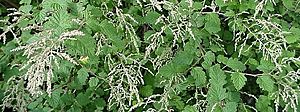Holodiscus facts for kids
Quick facts for kids Holodiscus |
|
|---|---|
 |
|
| Holodiscus discolor leaves and flower buds | |
| Scientific classification |
|
| Kingdom: | Plantae |
| Clade: | Tracheophytes |
| Clade: | Angiosperms |
| Clade: | Eudicots |
| Clade: | Rosids |
| Order: | Rosales |
| Family: | Rosaceae |
| Subfamily: | Amygdaloideae |
| Tribe: | Spiraeeae |
| Genus: | Holodiscus (K.Koch) Maxim. |
| Species | |
|
See text |
|
| Synonyms | |
|
Sericotheca |
|
Holodiscus is a group of flowering plants. They belong to the Rosaceae family, which also includes roses and apples! These plants are found in the Americas. You can find them from southwestern British Columbia, Canada, and the western United States all the way south to Bolivia.
These plants are deciduous shrubs. This means they are woody plants that lose their leaves every autumn. They can grow to be about 1 to 7 meters (3 to 23 feet) tall.
Types of Holodiscus Plants
Scientists have identified about seven to ten different types, or species, of Holodiscus. Here are some of them:
- Holodiscus australis: Found in the western US, like New Mexico.
- Holodiscus argenteus: Grows in Mexico.
- Holodiscus discolor: Also known as Ocean Spray. It's found along the coast of western North America.
- Holodiscus dumosus: Grows in the inland areas of western North America.
- Holodiscus fissus: Found in Central America.
- Holodiscus microphyllus: Grows in the western US, like Nevada and Utah.
- Holodiscus nitida: Found in Colombia.
- Holodiscus orizabae: Grows in southern Mexico.
- Holodiscus pernethyoides: Found in Bolivia.
- Holodiscus saxicola: Found in California, in the western US.
How Scientists Classify Holodiscus
The way scientists group Holodiscus within the Rosaceae family has changed over time. This happens as they learn more about plants. For a long time, Holodiscus was placed in a group called Maloideae.
However, newer studies use molecular biology. This means scientists look at the DNA of the plants. These studies show that the old Maloideae group actually fits inside a larger group called Amygdaloideae. So, Holodiscus is now considered part of the Amygdaloideae subfamily within the Rosaceae family.
See also
 In Spanish: Holodiscus para niños
In Spanish: Holodiscus para niños

